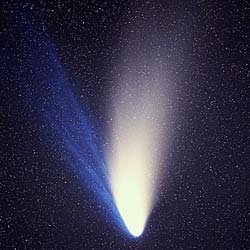International First: Gas-phase Carbonic Acid Isolated

In the tail of comets and other celestial bodies or astrophysical environments scientist suggest the existence of gas-phase carbonic acid, here comet Hale-Bopp. Photo: E. Kolmhofer, H. Raab; Johannes-Kepler-Observatory, Linz, Austria <br>
In textbooks and other media the widespread belief still prevails that stable carbonic acid cannot be produced in pure form and is practically non-existent as it immediately decomposes to carbon dioxide and water. However, Innsbruck chemists headed by Erwin Mayer (Institute of General, Inorganic and Theoretical Chemistry) refuted this persistent dogma in chemistry several years ago.
They belong to only a handful of scientists who have prepared pure solid carbonic acid experimentally. In an international first, the scientists have now produced gas-phase carbonic acid and, together with a research group headed by Hinrich Grothe at the Vienna University of Technology, they have also succeeded in proofing the existence of these molecules.
“Carbonic acid vapor is composed of at least three different species in the gas-phase: a cyclic dimer consisting of two molecules and two different types of monomers,“ explains Thomas Loerting (Institute of Physical Chemistry) the result of the comprehensive study.
Surprising result
For this experiment the researchers prepared carbonic acid in the laboratory in Innsbruck. It was then stored in liquid nitrogen and transported to Vienna by PhD student Jürgen Bernard. At the Institute of Materials Chemistry at the TU Wien the solid carbonic acid was warmed to minus 30 degrees Celsius. “During this process the carbonic acid molecules entered the gas-phase,“ says Loerting. This is a surprising result because many experts in the field believed that carbonic acid immediately decomposes to carbon dioxide and water. The Austrian scientists trapped the carbonic acid vapor in a solid matrix of the inert gas argon and cooled it down. “This produced a frozen image of the carbonic acid vapor, which we analyzed by using high-resolution infrared spectroscopy at the TU Wien,“ says Hinrich Grothe. “The spectrum we produced is extremely precise and we were able to assign the spectral bands to the vibration of each single molecule.“ For more than a decade, the chemists have been supported in their experimental research by Klaus Liedl from the Institute of Theoretical Chemistry in Innsbruck. His team of scientists has helped to interpret the experimental data with computational models. Additional calculations have been performed by Oscar Galvez from CSIC Madrid (Spanish National Research Council).
Infrared spectra in research
This experiment not only is of high importance for basic research but also for astronomy. The identification of gas-phase carbonic acid in the atmosphere of celestial bodies may be facilitated by the detailed spectra of gas-phase carbonic acid described in this study. “Conditions in space environments suggest that gas-phase carbonic acid may be found in the coma of comets or the poles of Mars,“ says Thomas Loerting. “However, infrared spectra currently measured in extraterrestrial environments are still too imprecise to be comparable to the results produced in our laboratory.“
The team of chemists headed by Loerting and Liedl are members of the research platform Advanced Materials of the University of Innsbruck and are supported by the Austrian Science Fund (FWF) and the European Research Council (ERC). The chemists in Vienna supervised by H. Grothe participate in the TU Wien Materials Research Cluster and are supported by the Austrian Exchange Service (ÖAD).
Contact:
Univ. Prof. Dr. Thomas Loerting
Institute of Physical Chemistry
University of Innsbruck
Innrain 52, 6020 Innsbruck, Austria
Phone: +43 512 507 5062
Email: Thomas.Loerting@uibk.ac.at
http://homepage.uibk.ac.at/~c724117/
Univ. Prof. Dr. Hinrich Grothe
Institute of Materials Chemistry
Vienna University of Technology
Lehargasse 2-4, 1060 Vienna, Austria
Phone: +43 1 58801 165122
Email: grothe@tuwien.ac.at
http://www.imc.tuwien.ac.at
Weitere Informationen:
http://dx.doi.org/10.1002/anie.201004729 – Spectroscopic Observation of Gas-Phase Carbonic Acid Isolated in Matrix. Jürgen Bernard, Markus Seidl, Ingrid Kohl, Klaus Liedl, Erwin Mayer, Oscar Gálvez, Hinrich Grothe, Thomas Loerting. Angewandte Chemie International Edition.
Media Contact
More Information:
http://www.imc.tuwien.ac.atAll latest news from the category: Life Sciences and Chemistry
Articles and reports from the Life Sciences and chemistry area deal with applied and basic research into modern biology, chemistry and human medicine.
Valuable information can be found on a range of life sciences fields including bacteriology, biochemistry, bionics, bioinformatics, biophysics, biotechnology, genetics, geobotany, human biology, marine biology, microbiology, molecular biology, cellular biology, zoology, bioinorganic chemistry, microchemistry and environmental chemistry.
Newest articles

Largest magnetic anisotropy of a molecule measured at BESSY II
At the Berlin synchrotron radiation source BESSY II, the largest magnetic anisotropy of a single molecule ever measured experimentally has been determined. The larger this anisotropy is, the better a…

Breaking boundaries: Researchers isolate quantum coherence in classical light systems
LSU quantum researchers uncover hidden quantum behaviors within classical light, which could make quantum technologies robust. Understanding the boundary between classical and quantum physics has long been a central question…

MRI-first strategy for prostate cancer detection proves to be safe
Active monitoring is a sufficiently safe option when prostate MRI findings are negative. There are several strategies for the early detection of prostate cancer. The first step is often a…



